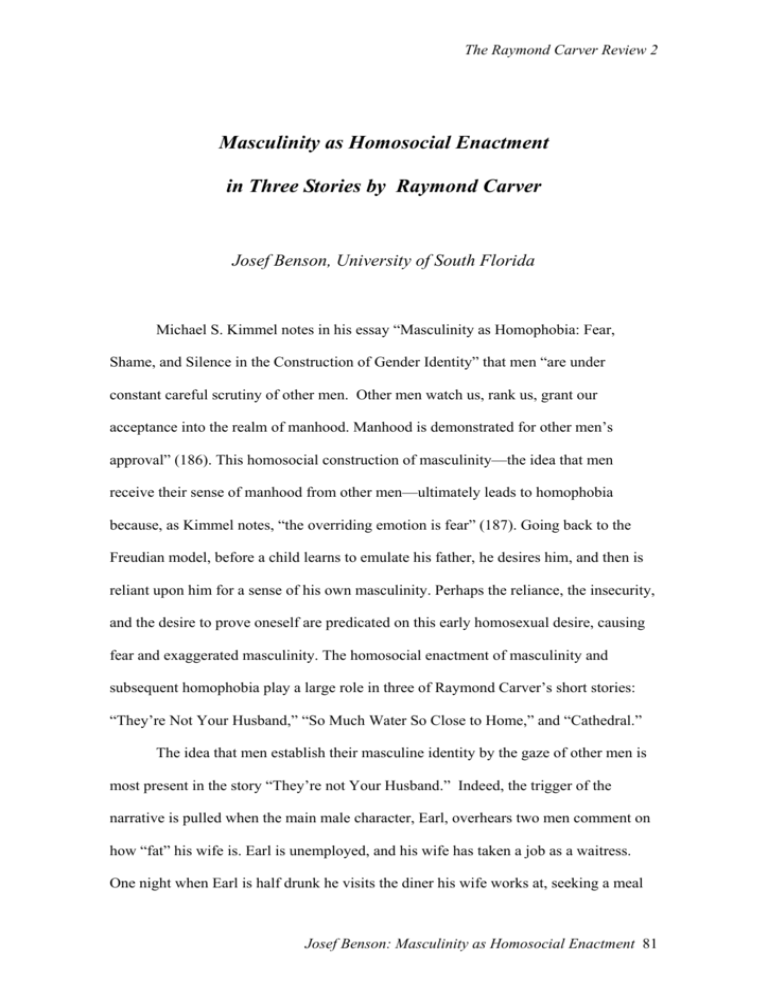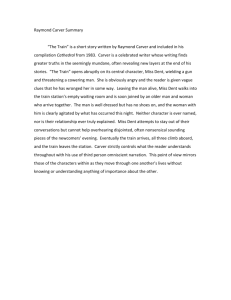Masculinity as Homosocial Enactment in Three Stories by Raymond
advertisement

The Raymond Carver Review 2 Masculinity as Homosocial Enactment in Three Stories by Raymond Carver Josef Benson, University of South Florida Michael S. Kimmel notes in his essay “Masculinity as Homophobia: Fear, Shame, and Silence in the Construction of Gender Identity” that men “are under constant careful scrutiny of other men. Other men watch us, rank us, grant our acceptance into the realm of manhood. Manhood is demonstrated for other men’s approval” (186). This homosocial construction of masculinity—the idea that men receive their sense of manhood from other men—ultimately leads to homophobia because, as Kimmel notes, “the overriding emotion is fear” (187). Going back to the Freudian model, before a child learns to emulate his father, he desires him, and then is reliant upon him for a sense of his own masculinity. Perhaps the reliance, the insecurity, and the desire to prove oneself are predicated on this early homosexual desire, causing fear and exaggerated masculinity. The homosocial enactment of masculinity and subsequent homophobia play a large role in three of Raymond Carver’s short stories: “They’re Not Your Husband,” “So Much Water So Close to Home,” and “Cathedral.” The idea that men establish their masculine identity by the gaze of other men is most present in the story “They’re not Your Husband.” Indeed, the trigger of the narrative is pulled when the main male character, Earl, overhears two men comment on how “fat” his wife is. Earl is unemployed, and his wife has taken a job as a waitress. One night when Earl is half drunk he visits the diner his wife works at, seeking a meal Josef Benson: Masculinity as Homosocial Enactment 81 The Raymond Carver Review 2 on the house. While sitting at the counter he hears two men chatting about his wife. One man comments, “Look at the ass on that. I don’t believe it . . . some jokers like their quim fat” (45). Wounded in his masculinity, Earl at that point becomes determined to regain it by imposing a diet on his wife. In “So Much Water So Close to Home” the narrator, Claire, tells the story of her husband, Stuart, and his friends finding a dead naked girl on their fishing trip. Instead of immediately calling the authorities and risking an abrupt end to their getaway they go ahead and drink and fish for a few days, deciding to cut their weekend short by only one day instead of missing out on the whole thing. What keeps the men from reporting the dead woman is their collective desire to prove their masculinity to each other. No one wants to be the sissy who decides to cut the trip short. Had any women been around with the men, the chances that anyone would put their hook in the water would have been presumably slimmer. Indeed, when Stuart realizes the extent of Claire’s outrage he tells her, “I won’t have you passing judgment on me. Not you” (214). This statement suggests Stuart is used to having others pass judgment on him, namely other men, but will not allow his wife, or perhaps any woman, the same luxury; it could also suggest that his wife’s (a woman’s) judgment counts little, or less than that of the men. The two different versions of this story found in the early What We Talk About When We Talk About Love and the later Where I’m Calling From differ little in the primary conflict, that of the men privileging their fishing trip over the humanity of a girl whom they have never met. In his treatment of the both stories two stories, Gunter Leypoldt deals mostly with either the minimalism/realism discussion or Claire’s unreliability as a narrator in the longer version. What this focus fails to see is that Claire is a completely different character in the second, longer, version, a more empowered female character, or as Sandra Lee Kleppe points out in her article, “Women and Josef Benson: Masculinity as Homosocial Enactment 82 The Raymond Carver Review 2 Violence in the Stories of Raymond Carver,” a more “independen[t]” (17) woman, suggesting that indeed Carver was in fact conscious of the gender threads of his story. Lastly and perhaps most importantly, because the homosocial construction is undercut, is Carver’s most anthologized work “Cathedral.” Kimmel points out that it is the eyes of other men, their seeing, which promotes masculine performance. In “Cathedral” there is immediate tension between the unnamed narrator and Robert, a blind man for whom the narrator’s wife once worked. The narrator is clearly uncomfortable having the blind man in his house. He claims it is mostly due to the fact that the man is blind, but it is fairly obvious that he fears Robert will usurp the narrator’s masculinity and perhaps steal his wife. It is only when the narrator begins to come to terms with the actuality of Robert’s blindness that the homosocial construct of masculinity breaks down. Indeed, it is because Robert is blind and cannot see the narrator or his wife that the narrator mistakenly feels Robert cannot possibly steal his wife or usurp his masculinity, suggesting that the homosocial construction is predicated on the gaze, and without the gaze, there is no threat. Only when the homosocial tension between the narrator and Robert is released can the narrator and Robert connect spiritually. Indeed, only then is the narrator’s homophobia vaporized. The homosocial construct of masculinity is predicated on other men but also on women. Yet it is not the direct presence of women or the direct interaction of women with men that provokes homosocial masculinity. It is rather the absence of the female that allows men to confront other men. In the case of “They’re Not Your Husband” Doreen is present in the diner, but she is absent in that she is waiting on Earl and the other two men. She is liminalized. Likewise in “So Much Water So Close to Home” the dead woman is present in the water, but she is dead and so absent. Finally, in “Cathedral,”throughout most of the story the wife is either locked in the past as the Josef Benson: Masculinity as Homosocial Enactment 83 The Raymond Carver Review 2 narrator tells her story or has passed out on the couch. She is the impetus of the conflict and yet she is hardly in the story as she participates very little in the dialogue between the two men at the end. Interestingly, the opening sentence of the story, “Earl Ober was between jobs as a salesman” (44), tells the reader that Earl is in an insecure space. Kimmel asserts that first and foremost it is “Marketplace Masculinity” that defines manhood (184). Given that Earl is jobless, he already feels emasculated before he even hears the two men disparage his wife. After the men initially comment on Earl’s wife’s “ass,” his wife, while scooping out some ice cream, shows her “thighs that were rumpled and gray and a little hairy, and veins that spread in a berserk display. The two men sitting beside Earl exchanged looks” (45). Before Earl eavesdrops on the two men and finds out what they think about his wife he has had no problem with her appearance. Once he realizes that his wife is not coveted by other men, she is no longer attractive to Earl. It is in this instance that Earl is defining his own masculinity by the gaze of other males. Finally, when Doreen begins “shaking the can of whip cream, Earl g[e]t[s] up, leaving his food, and head[s] for the door” (45). The phallic symbol of the can of whipped cream and the sight of his wife shaking it is too much for Earl. Not only is Earl ashamed of the fact that he is unemployed and reliant on the wages of his wife, but now he is further emasculated by the notion that he is married to an unattractive woman. Kimmel maintains, “Masculinity becomes a defense against the perceived threat of humiliation in the eyes of other men” (193). The next morning Earl is hell bent on rescuing his flagging sense of manhood when he tells Doreen: “Just look at yourself in the mirror . . . I hate to say anything . . . but I think you better give a diet some thought” (46). Of course Earl does not mention where his new found concern for his wife’s figure stems from, and consequently Doreen is surprised and perhaps a little flattered that Earl Josef Benson: Masculinity as Homosocial Enactment 84 The Raymond Carver Review 2 is paying attention to her at all. Rather than get upset Doreen simply mentions that Earl “never said anything before” (46). Perhaps the most tragic aspect of this is that Earl is not at all concerned with his wife’s health. If he had recommended to his wife that she exercise or that the two of them eat better, perhaps he would not seem so selfish and superficial and failingly human. He would still appear weak and insecure but not dangerous, as he appears when he tells Doreen “Just quit eating . . . for a few days anyway” (47). Kimmel further insists that “Manhood is equated with power—over women” (193). No doubt this is the case when Earl becomes Doreen’s weight loss coach. Indeed, Earl is the overseer of his wife’s body, having “Doreen take off all her clothes and get on the scale. He frowned when he saw the veins. He ran his finger the length of one that sprouted up her thigh” (47). It is important to note that Doreen is not blameless. She allows Earl to bully her into starving herself. Perhaps as mentioned earlier, she simply likes the attention her husband is giving her. Nonetheless, after Doreen has lost nearly ten pounds, Earl stops by the diner to reap his rewards. Now that in his mind his wife is no longer “fat,” he can feel more secure in his manliness, even though Doreen tells him that people at work have told her that she is “too pale” (49). Of course, Earl’s response is “they’re not your husband” (49), invoking the title of the story. But the joke is on Earl, for when he beseeches a random male customer to “Look at the ass on her” (51), meaning Doreen, the stranger does not take the bait and grant Earl his masculinity. Instead, the man merely “rattle[s] the newspaper” (51). Further, when one of the other waitresses asks Doreen, “who is this joker, anyway,” (52) referring to Earl, Doreen responds, “He’s a salesman. He’s my husband” (52). But in fact Earl is not a salesman. He is unemployed. Clearly, Doreen does not want to admit that Earl is unemployed and in a strange parallel risk her own homosocial femininity. Josef Benson: Masculinity as Homosocial Enactment 85 The Raymond Carver Review 2 It seems that the gaze of others necessitates a shift in space and context for the object. In this case, when Earl is seeing Doreen through the eyes of the other males she is not his wife. She is a waitress and a woman, an object for the use of men. One could say that Doreen is present as a consumable object, but absent as a sentient human being. This notion of absence and presence comes up repeatedly when examining the construction of masculinity through homosocial relations. In looking at “So Much Water So Close to Home,” especially in terms of gender, one must deal with the fact that the two versions of the story are narrated by two different characters. In the shorter Lish/Carver 1 version found in “What We Talk About When We Talk About Love,” the narrator Claire is simply a weaker person. In his article “Reconsidering Raymond Carver’s ‘Development’: The Revisions of ‘So Much Water so Close to Home,’” Gunter Leypoldt focuses on Claire’s obvious emotional problems, made clear in the longer version but which are absent in the shorter version. Further, Leypoldt notes that in the shorter version Carver treats “the theme [rape] quite differently, with Claire immediately accepting Stuart’s sexual offer” (333). Leypoldt is quite right that Claire is a more rounded character in the longer version. Not only does Claire not accept Stuart’s advances at the end of the story in the longer one, she violently rejects him, “stamp[ing] on his toes” (Where I’m Calling 236), causing Stuart to snap “you go to hell then, do you hear, bitch?” (236). The other telling difference in the two stories is that in the shorter one on the night Stuart comes home from the fishing trip and gets into bed with Claire, she admits, “I turned and opened my legs” (What We Talk About 82). Contrarily, in the longer version Claire admits “I turned slightly and then moved my legs” (Where I’m Calling 217). This is significant because in the longer version Claire does not give in to Stuart. She is a much stronger person and is simply not the Claire of the shorter Lish version. Consequently, one could make the argument Josef Benson: Masculinity as Homosocial Enactment 86 The Raymond Carver Review 2 that Carver was very interested in giving Claire more agency. He clearly was not comfortable with Claire as a helpless, sexualized, indeed hysterized 2 woman. That said, the homosocial element is evident in both versions but the spatial relationships are more pronounced in the longer version—the idea that when women are present and interactive men are not as prone to homosocial constructions of masculinity—and so all references to this story will be in terms of the longer version Where I’m Calling From. Kimmel believes that “as adolescents, we learn that our peers are a kind of gender police constantly threatening to unmask us as feminine, as sissies” (190). The fact is, if Stuart and his buddies do the right thing by contacting the authorities once they find the girl, perhaps Stuart and Claire’s relationship would not decline so precipitously. Further, though we do not find out if the other men are having difficulty explaining themselves to their wives and others, one may reasonably assume they are. So the question is why do the men continue their leisure fishing trip in the face of death and dehumanization? The answer is that none of them want to be looked at as the “sissy” who flakes out and squeals. Carver writes, even before they set up camp, Mel Dorn found the girl floating face down in the river, nude, lodged near the shore in some branches. He called the other men and they all came to look at her. They talked about what to do. One of the men—Stuart didn’t say which—perhaps it was Vern Williams, he is a heavy-set, easy man who laughs often—one of them thought they should start back to the car at once. The others stirred the sand with their shoes and said they felt inclined to stay. They pleaded fatigue, the late hour, the fact that the girl “wasn’t going anywhere.” In the end they all decided to stay. (215) Josef Benson: Masculinity as Homosocial Enactment 87 The Raymond Carver Review 2 Interrestingly, Claire, who is still narrating, conjectures that it may have been Vern, the fat man who laughs a lot. Kimmel notes that “We come to know what it means to be a man in our culture by setting our definitions in opposition to a set of ‘others’—racial minorities, sexual minorities, and above all, women” (182). Perhaps Claire imagines Vern Williams being the one who suggests that they turn back because Vern is the most feminine, marked with fleshiness and a feminine penchant for laughter. 3 Interesting to note as well is the fact that Stuart, maintaining the masculine code till the end “didn’t say which” man it was who wanted to “start back to the car at once.” Regardless of who it was, he did not have the power to break the homosocial bond of the other men. The man who decided to turn back would forever be banned from future fishing trips and marked as other. Later, it is pointed out through Claire’s retelling 4 that “Vern Williams went to sleep, but the others told coarse stories and spoke of vulgar or dishonest escapades out of their past, and no one mentioned the girl” (216). Whether of his own volition or by the silent disapproval of the other men, Vern has been banished from the male group while they one up each other in anecdotal masculinity. Kimmel further notes that “Homophobia is the fear that other men will unmask us, emasculate us, reveal to us and the world that we do not measure up, that we are not real men” (189). It is this homophobia that causes the men to not act, to not show compassion for the dead girl or the dead girl’s family. Kimmel goes on to say, “The fear—sometimes conscious, sometimes not—that others might perceive us as homosexual propels men to enact all manner of exaggerated masculine behaviors” (191). Exaggerated masculinity is shown when one of the men Claire surmises might be Stuart, fearing he might be the real culprit, waded into the water and took the girl by the fingers and pulled … her, still face down, closer to shore, into shallow water, and then took a piece Josef Benson: Masculinity as Homosocial Enactment 88 The Raymond Carver Review 2 of nylon cord and tied … it around her wrist and then secured … the cord to tree roots. (216) One must consider the coarseness of this act. Rather than honor the life of the naked dead girl, the men further dehumanize her by tying her by the wrist to a tree. If the men had not so recently experienced a litmus test for their masculinity, one that Vern Williams surely failed, none of them would have been so quick to prove how vulnerable they are to fly from anything feminine. feminine flight. Similar to Doreen in “They’re Not Your Husband,” who occupies a space that is both present and absent in that she is present as a server but absent as Earl’s wife, the dead girl is both present, occupying space in the water, and absent because she is dead. Indeed, the dead girl represents the feminine which Kimmel notes “threatens emasculation by representing the home, workplace, and familial responsibility, the negation of fun” (191), the very thing the men are running from. After the dead girl is fastened to the “roots of a tree” the men comment on the “firmness of the trout they’d caught, and the terrible coldness of the river water” (216). Carver writes that “they stopped talking then” (216). It is the presence of the dead girl that they are really referring to without mentioning her and so her absence in death is more powerful than if she were alive. The strongest feature of the homosocial enactment of masculinity is the visual. Kimmel maintains that the father is the first man who evaluates the boy’s masculine performance, the first pair of male eyes before whom he tries to prove himself. Those eyes will follow him for the rest of his life. Other men’s eyes will join them—the eyes of role models, such as teachers, coaches, bosses, or media heroes; the eyes of his peers, his friends, his workmates; Josef Benson: Masculinity as Homosocial Enactment 89 The Raymond Carver Review 2 and the eyes of millions of other men, living and dead, from whose constant scrutiny of his performance he will never be free. (188) The reason the homosocial and subsequent homophobia break down in “Cathedral” is because the narrator’s rival, the other man, the other pair of eyes, Robert, is blind. Once the narrator, never named, comes to terms with Robert’s blindness, he no longer feels threatened and therefore does not feel the need to prove his masculinity. And once this insecure need is gone he is able to connect humanly with another man without the fear of being regarded as homosexual. It is clear from the beginning of the story that the narrator considers Robert a rival for his wife. Referring to her, the narrator admits, “She and the blind man had kept in touch. They made tapes and mailed them back and forth. I wasn’t enthusiastic about his visit. He was no one I knew. And his being blind bothered me” (356). Because the narrator has never previously met anyone who is blind—the narrator admits, after all, that his “idea of blindness came from the movies” (356)—in his ignorance he finds Robert’s presence disturbing. Indeed the narrator admitsInterestingly, when the narrator’s wife tells the narrator that the blind man has recently lost his wife, he considers what a tragedy it is that the woman, named Beulah, “could never see herself as she was seen in the eyes of her loved one. A woman whose husband could never read the expression on her face” (360). This proposition sounds heinous to the narrator because he and the other men of the other stories are used to determining their masculinity through the eyes of others, usually other men. Further, it is clear that the narrator is suggesting that Beulah’s identity is interrupted by the fact that she cannot “see herself” as Robert, her man, sees her. Soon, however, as the narrator begins to realize what it really means to be blind, his preconceived notions of blindness are dashed: Josef Benson: Masculinity as Homosocial Enactment 90 The Raymond Carver Review 2 I remembered having read somewhere that the blind didn’t smoke because, as speculation had it, they couldn’t see the smoke they exhaled. I thought I knew that much and that much only about blind people. But this blind man smoked his cigarette down to the nubbin. (363) Yet Robert’s blindness simultaneously puts the narrator at ease, in so far as he no longer feels he will be unmasked, as it also disconcerts him, since he cannot use the other’s gaze as a means to construct his own masculinity. It sets him apart as the other and therefore disarms him, as it also allows the narrator to engage himself without fear. Nonetheless, a life of homosocial masculinity construction cannot be rid of in one night. When the narrator’s wife falls asleep on the couch with her robe open and showing “a juicy thigh” (368), it is more than the narrator is comfortable with, as he admits with some self-deprecation, “I reached to draw her robe back over her, and it was then that I glanced at the blind man. What the hell! I flipped the robe open again” (368). His wife’s humanity only matters in so far as it affects the narrator. Never mind that his wife, even though Robert is blind, probably would rather not be showing “a juicy thigh” if for no other reason than because Robert is blind and it does not seem right to treat him any differently, for example strutting around the house in the nude simply because the blind man cannot see her. Again, what allows the homosocial bonding and subsequent breakdown due to Robert’s blindness to take place, is the absent presence of the wife. She is in the story either in flashback or upstairs or asleep when all of the bonding takes place between the narrator and Robert. When she is awake the narrator merely feels left out “wait[ing] in vain to hear [his] name on [his] wife’s sweet lips” (364-65). In all three stories the women are more present in their absence, allowing the construction, or deconstruction Josef Benson: Masculinity as Homosocial Enactment 91 The Raymond Carver Review 2 in the case of “Cathedral,” of masculinities to occur among the males. The difference in “Cathedral” is that since Robert is non-threatening in his blindness and cannot unmask the narrator with his gaze, the narrator is finally free to connect with Robert without fearing that Robert or his wife will deem him homosexual. And thus, the narrator agrees to help Robert understand what a cathedral is by literally drawing a cathedral with Robert hand in hand: He found my hand, the hand with the pen. He closed his hand over my hand. “Go ahead, bub, draw,” he said. “Draw. You’ll see. I’ll follow along with you. It’ll be okay. Just begin now like I’m telling you. (373) One gets the feeling that Robert, whose blindness has enlightened him to a degree, has done this sort of thing before, been the great emancipator for frightened men. Indeed, Robert quips, “Never thought anything like this could happen in your lifetime, did you, bub? Well, it’s a strange life, we all know that” (373). Some critics such as Kirk Nesset believe that “Cathedral” is about the narrator leaving the confines of himself, exiting his insularity in order to enter into a “gesture of fraternity” (125) with the blind man. I would argue that the narrator is now able to leave the social world and enter himself without fear. He is now able to commune with Robert emotionally and spiritually from the inside, and by thus being safe within himself he is able to free himself from his own gaze, from his own partnership in the homosocial enactment of masculinity. When the narrator’s wife interrupts them by asking them “What’s going on?” (374), Robert tells the narrator to “close your eyes now” (374). After the two are done drawing the cathedral, Robert tells the narrator to “take a look” (374). But the narrator is not ready to give up the sheer bliss of not being weighted down by the possibility that his new found freedom will be interrupted by the presence Josef Benson: Masculinity as Homosocial Enactment 92 The Raymond Carver Review 2 of his wife, and so he admits “My eyes were still closed. I was in my house. I knew that. But I didn’t feel like I was inside anything. ‘It’s really something,’ I said” (375). Of course what the narrator is referring to is not the cathedral; it is—perhaps for the first time—the way it feels to connect with another man without the fear of being disempowered. The question frequently asked is, did the author realize what he was doing? In this case, was Raymond Carver aware of the gender implications in these stories? A question such as this has no answer, but keeping in mind the changes in “So Much Water So Close to Home” it seems clear that yes, Carver was conscious of how he was characterizing females. If indeed it was Lish who initially shortened the story, then it was clearly Carver who lengthened the later version and empowered the narrator, Claire. In all three of these stories men rely on other men to establish or maintain their masculinity. Further, the women are more present in their absence or distorted context, allowing the males to proceed in their dialectical bonding, and emasculation. The exception is the ending of “Cathedral” where, given the reliance of the homosocial on the male gaze and the blindness of the main male counterpart and rival, the homosocial construct breaks down, allowing the narrator and Robert to share a moment of freedom and spiritual connection. Looked at together, these three stories are interesting because they not only depict relationships between men and women but also the relationships between men in relation to women. No doubt the stories in Cathedral and several of the later stories in Carver’s oeuvre suggest an opening up of sorts, a gravitation toward connection instead of disconnection and the possibility, though small, of moments of grace. Josef Benson: Masculinity as Homosocial Enactment 93 The Raymond Carver Review 2 Notes 1 As is well known, Gordon Lish was Carver’s editor for this manuscript and heavily revised the story causing Carver at one point to plead with Lish not to publish the book. More can be found about this in D.T. Max’s New York Times Magazine article, “The Carver Chronicles.” 2 Michel Foucault defines this term in The History of Sexuality: “A hysterization of women’s bodies: a threefold process whereby the feminine body was analyzed--qualified and disqualified--as being thoroughly saturated with sexuality” (104). 3 This strikes me as aligning with those theorists such as Judith Butler who claim that gender is entirely performed. As she notes in “Performative Acts and Gender Constitution”: “those who fail to do their gender right are regularly punished” (903). Vern here is being assigned his gender failure by Claire, because in her mind he is not “doing” his gender correctly. Perhaps rather than one performing his or her gender, it is the other, the audience witnessing the performance, a performance that is unwitting and perhaps not a performance at all, who are really the ones who are taking part in a “performance.” 4 It is important to note that Claire is the one telling the story and that her reliability is certainly in question. As readers we are not privy to all of what Stuart has told Claire and even if we were, even if the story was narrated by Stuart, his reliability would be in question as well. In a sense we must simply take Claire’s word for it as to what really happened, though the basic facts seem to be undisputed. Josef Benson: Masculinity as Homosocial Enactment 94 The Raymond Carver Review 2 Works Cited Butler, Judith. “Performative Acts and Gender Constitution.” Literary Theory: An Anthology. Ed. Julie Rivkin and Michael Ryan. Malden: Blackwell, 2004. Carver, Raymond. “Cathedral.” Where I’m Calling From. New York: Random House, 1988. ---. “So Much Water So Close to Home.” What We Talk About When We Talk About Love. New York: Random House, 1981. ---. “So Much Water So Close to Home.” Where I’m Calling From. New York: Random House, 1988. ---. “They’re Not Your Husband.” Will You Please Be Quiet, Please? London: Vintage, 2003 (1973). Foucault, Michel. The History of Sexuality: An Introduction. Vol. 1. Trans. Robert Hurley. New York: Random House, 1990. Kimmel, Michael S. “Masculinity as Homophobia: Fear, Shame, and Silence in the Construction of Gender Identity.” Feminism and Masculinities. Oxford: Oxford University Press, 2004: 182-99. Kleppe, Sandra Lee. “Women and Violence in the Stories of Raymond Carver.” Journal of the Short Story in English 46 (Spring 2006): 107-117. Leypoldt, Gunter. “Reconsidering Raymond Carver’s ‘Development’: The Revisions of ‘So Much Water So Close to Home.’” Contemporary Literature 43:2 (Summer 2002): 317-341. Max, D.T. “The Carver Chronicles.” The New York Times Magazine 9 Aug. 1998: 3256. Nesset, Kirk. “Insularity and Self-Enlargement in Raymond Carver’s ‘Cathedral.’” Essays in Literature 21.1 (Spring 1994): 116-129. Josef Benson: Masculinity as Homosocial Enactment 95








